1) Which of the following blood vessels carries blood away from the heart to other organs?
- a) arteries
- b) capillaries
- c) venules
- d) arterioles
- e) veins
a
2) Which of the following blood vessels carries blood from the tissues back to the heart?
- a) arteries
- b) arterioles
- c) aorta
- d) veins
- e) capillaries
d
3) Which layer of the arterial wall is responsible for vasoconstriction?
- a) tunica interna
- b) tunica media
- c) tunica externa
- d) tunica albuginea
- e) tunica fascia
b
4) A blockage in the proximal portion of the right subclavian artery will not only affect circulation to the right arm, but also to the
- a) left arm
- b) left ventricle
- c) right ventricle
- d) left vertebral artery
- e) left common carotid artery
d
5) The bronchial arteries arise from the
- a) left subclavian artery
- b) brachiocephalic trunk
- c) right subclavian artery
- d) left common carotid artery
- e) thoracic aorta
e
6) A blockage in the external iliac artery will reduce blood flow to the
- a) external iliac artery
- b) common iliac artery
- c) femoral artery
- d) abdominal aorta
- e) ileal artery
c
7) In resting individuals, which vessels serve as a large blood reservoir from which blood can be quickly diverted to other vessels as needed?
- a) Arteries and arterioles
- b) Arterioles and capillaries
- c) Venules and capillaries
- d) Veins and venules
- e) Aorta and veins
d
8) In order to supply nourishment to liver tissue, which vessel must deliver blood to the organ?
- a) hepatic artery
- b) hepatic vein
- c) hepatic portal vein
- d) superior mesenteric artery
- e) splenic artery
a
9) If a patient is confined to bed and is unable to walk at all, which of the following will be seriously affected?
- a) blood flow to the lungs
- b) blood flow to the kidneys
- c) the circulation returning from the lower body
- d) circulation in the jugular veins
- d) blood flow to the intestines
c
10) Capillaries are also referred to as
- a) exchange vessels.
- b) vasoconstrictors.
- c) vasodilators.
- d) pressure reservoirs.
- e) distributing vessels.
a
12) The layer of a blood vessel that is in direct contact with the blood is the
- tunica albuginea
- tunica externa
- tunica interna
- tunica media
- tunica vasculosa
c
the layer of the vessel that is made up of smooth muscle and elastic fibers is the
- tunica albuginea
- tunica externa
- tunica interna
- tunica media
- tunica vasculosa
d
13) Which of the following is the most important method of capillary exchange?
- a) diffusion
- b) facilitated diffusion
- c) bulk flow
- d) primary active transport
- e) secondary active transport
a
14) Which of the following structures is used to control the flow of blood through a capillary bed?
- a) thoroughfare channels
- b) precapillary sphincters
- c) postcapillary sphincters
- d) venules
b
15) Which of the following types of tissues contains continuous capillaries?
- a) skeletal muscle
- b) smooth muscle
- c) connective tissue
- d) lungs
- e) all of these choices
e
16) The alternate route of blood flow to a body part through an anastomosis is called
- a) a thoroughfare channel.
- b) a blood reservoir.
- c) a detour route.
- d) collateral circulation.
- e) microcirculation.
d
17) The largest driving force for pulling fluid from the interstitial spaces back into the capillaries is
- a) interstitial fluid hydrostatic pressure.
- b) interstitial fluid osmotic pressure.
- c) blood colloid osmotic pressure.
- d) blood hydrostatic pressure.
- e) glomerular hydrostatic pressure.
c
18) The pressure-driven movement of fluids and solutes from blood into interstitial fluid is called
- a) reabsorption.
- b) filtration.
- c) bulk flow.
- d) osmosis.
- e) transcytosis.
b
19) The volume of blood that circulates through the systemic (or pulmonary) blood vessels per minute is called
- a) stroke volume.
- b) tidal volume.
- c) cardiac output.
- d) cardiac reserve.
- e) total peripheral resistance.
c
20) Cardiac output is dependent on both
- a) heart rate and stroke volume.
- b) stroke volume and systemic vascular resistance.
- c) heart rate and systemic vascular resistance.
- d) blood type and stroke volume.
- e) blood pressure and heart rate
a
21) Vascular resistance depends on which of these factors? Select all that apply.
- a) size of the blood vessel lumen
- b) blood viscosity
- c) total blood vessel length
- d) glucose content of the blood
a,b,c
22) Which of the following would NOT result in an increase in arterial blood pressure?
- a) Increased blood volume
- b) Increased sympathetic stimulation
- c) Increased heart rate
- d) Increased stroke volume
- e) Increased arteriolar vasodilation
e
23) Which of the following would NOT result in an increase in systemic vascular resistance?
- a) Decreased diameter of systemic arterioles
- b) Increased blood viscosity
- c) Decreased length of the systemic circulatory route
- d) Increased vasoconstriction of systemic arterioles
- e) Increased red blood cell count
c
24) The right common carotid artery branches directly off the
- a) left common carotid artery
- b) left subclavian artery
- c) brachiocephalic trunk
- d) right subclavian artery
- e) right coronary artery
c
25) Which of the following is NOT a contribution of the cardiovascular system to other body systems?
- a) Blood delivers clotting factors and WBCs that aid in hemostasis when skin is damaged.
- b) Blood delivers calcium and phosphate ions that are needed for building bone extracellular matrix.
- c) Blood carries carbon dioxide to body tissues and removes oxygen for use by other organs.
- d) Blood carries newly absorbed nutrients and water to the liver.
- e) Blood circulates cells and chemicals that carry out immune functions.
c
26) The cardiovascular center is located
- a) in the thoracic cavity.
- b) in the cerebral cortex.
- c) in the cerebellum.
- d) in the medulla oblongata.
- e) in the hypothalamus.
d
27) The most common disorder affecting the heart and blood vessels is
- a) hypotension
- b) aneurysm
- c) infarction
- d) arrhythmia
- e) hypertension
e
28) Pericardial arteries supply blood to the
- a) outer heart muscle
- b) tissue of the aorta
- c) tissue of the pulmonary trunk
- d) tissues of the pericardial sac
- e) all of these
d
29) Which of the following hormones would NOT stimulate changes that lead to an increase in arterial blood pressure?
- a) Atrial natriuretic peptide (ANP)
- b) Antidiuretic hormone (ADH)
- c) Aldosterone
- d) Angiotensin II
- e) Norepinephrine
a
30) Blood flow passing through the posterior aspect of the knee is achieved through the
- a) tibial arteries
- b) popliteal arteries
- c) common iliac arteries
- d) internal iliac arteries
- e) external iliac arteries
b
32) The circulatory system aids in the homeostasis of the skeletal system by
- a) delivering calcium
- b) delivering phosphate
- c) transporting hormones for bone metabolism
- d) transporting hormones for production of red blood cells
- e) all of the above
e
33) Nutrients from digested food enter the liver via the
- a) hepatic portal circulation
- b) hepatic vein
- c) abdominal aorta
- d) inferior vena cava
- e) renal veins
a
34) Abnormal conditions such as atherosclerosis and patent (open) ductus arteriosus cause a large increase in the
- a) blood colloid osmotic pressure.
- b) net filtration pressure
- c) pulse pressure.
- d) blood hydrostatic pressure.
- e) interstitial fluid hydrostatic pressure.
c
35) The branches from the ascending aorta that supply blood to the cardiac muscle are the
- a) circumflex arteries
- b) coronary arteries
- c) anterior descending arteries
- d) interventricular arteries
- e) pulmonary arteries
b
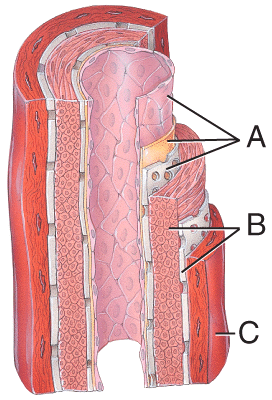
38) Which of the labeled layers in the diagram of the arterial wall consists mainly of elastic fibers and smooth muscle fibers?
b

39) Which of the labeled layers in the diagram of the arterial wall is composed of a simple squamous epithelium, a basement membrane and a layer of elastic tissue?
a
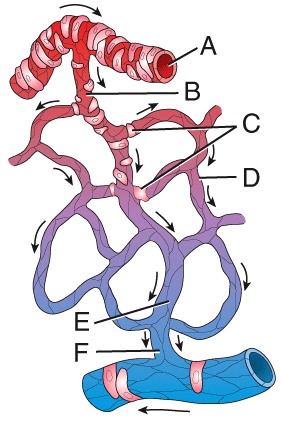
40) Which labeled structure in the figure is a metarteriole?
b
41) A blockage to one or both of the inferior phrenic veins will cause a backup of blood into which structure?
- a) the liver
- b) the kidney
- c) the heart
- d) the diaphragm
- e) the spleen
d

42) Which labeled structure in the figure is precapillary sphincter?
c
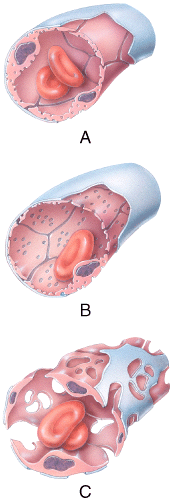
43) Which of the capillaries shown in the figure has an incomplete or absent basement membrane?
c

44) Which of the types of capillaries shown in the figure is commonly found in the kidneys, villi of the small intestine, choroid plexuses, and some endocrine glands?
b
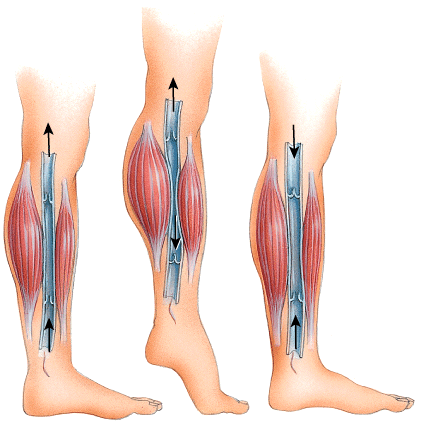
45) What physiological process is depicted in this figure?
- a) Venous blood blockage
- b) Skeletal muscle pump
- c) Respiratory pump
- d) Thoroughfare channels
- e) Anastomosis
b
47) Which of the following would NOT occur in response to hypovolemic shock?
- a) Activation of the renin-angiotensin-aldosterone (RAA) system.
- b) Secretion of antidiuretic hormone (ADH)
- c) Activation of the sympathetic division of the ANS.
- d) Release of atrial natriuretic peptide (ANP).
- e) Release of local vasodilators.
d
48) All the veins of the systemic circulation eventually drain into the
- a) superior vena cava.
- b) inferior vena cava.
- c) coronary sinus.
- d) superior and inferior vena cava.
e) superior and inferior vena cava and coronary sinus
e
49) The pulmonary trunk divides into
- a) brachiocephalic trunk and left subclavian artery
- b) right and left subclavian arteries.
- c) right and left pulmonary veins.
- d) right and left pulmonary arteries.
- e) right and left common carotid arteries.
d
50) If the foramen ovale doesn’t close at birth, the result will be
- a) overloading the lungs with blood
- b) excessive volume in the pulmonary trunk
- c) a reduction of volume in the aorta
- d) introducing deoxygenated blood into the systemic circulation
- e) no change in the content of the systemic or pulmonary circulations
d
52) Which of the following vessels supplies blood to the intestines?
- a) Radial artery
- b) Subclavian artery
- c) Mesenteric artery
- d) Coronary artery
- e) Popliteal artery
c
54) Which of the following vessels drains blood from the lower leg?
- a) Jugular vein
- b) Superior vena cava
- c) Tibial vein
- d) Coronary vein
- e) Inferior mesenteric vein
c
55) Which of the following vessels drains blood from the head and neck?
- a) Median cubital vein
- b) Inferior vena cava
- c) Axillary vein
- d) Femoral vein
- e) Jugular vein
e
56) Which of the following vessels carries the venous blood from the lower body into the right atrium?
- a) Inferior vena cava
- b) Superior vena cava
- c) Tibial vein
- d) Coronary vein
- e) Iliac vein
a
57) When the umbilical cord is tied after birth, the umbilical arteries close by filling in with
- a) placental fluid.
- b) platelet plugs.
- c) connective tissue.
- d) smooth muscle.
- e) epithelial tissue.
c
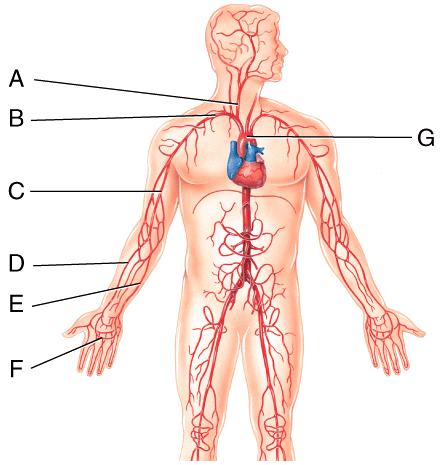
63) Which vessel in the figure is labeled “B”?
- a) right ulnar artery
- b) right subclavian artery
- c) right radial artery
- d) right brachial artery
- e) right axillary artery
b

64) Which vessel in the figure is labeled “A”?
- a) right subclavian artery
- b) right radial artery
- c) right common carotid artery
- d) right brachial artery
- e) right axillary artery
c
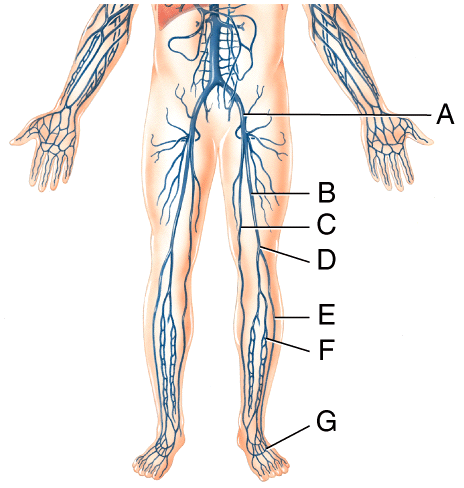
65) Which vessel in the figure is labeled “B”?
- a) left femoral vein
- b) left great saphenous vein
- c) left popliteal vein
- d) left anterior tibial vein
e) left fibular vein
a

66) Which vessel in the figure is labeled “C”?
- a) left femoral vein
- b) left great saphenous vein
- c) left popliteal vein
- d) left anterior tibial vein
- e) left fibular vein
b

67) Which vessel in the figure is labeled “F”?
- a) left femoral vein
- b) left great saphenous vein
- c) left popliteal vein
- d) left anterior tibial vein
- e) left small saphenous vein
d
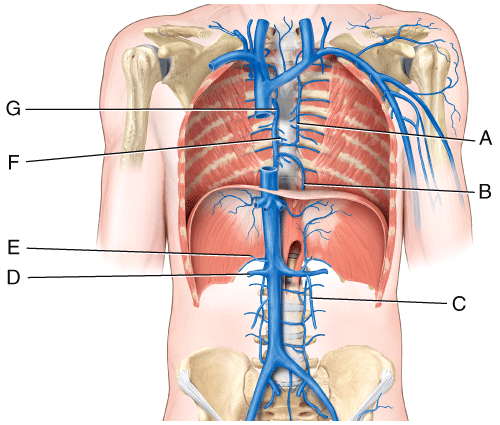
68) Which vessel in the figure is labeled “C”?
- a) accessory hemiazygos vein
- b) hemiazygos vein
- c) left gonadal vein
- d) right renal vein
- e) right suprarenal vein
c

69) Which vessel in the figure is labeled “D”?
- a) accessory hemiazygos vein
- b) hemiazygos vein
- c) right renal vein
- d) right suprarenal vein
- e) pericardial vein
c

70) Which vessel in the figure is labeled “G”?
- a) accessory hemiazygos vein
- b) hemiazygos vein
- c) right suprarenal vein
- d) pericardial vein
- e) azygos vein
e
71) In the fetal heart, several structures allow blood from the left and right sides to mix. When the newborn takes its first breath, these structures must close to ensure that oxygenated blood from the left side does not mix with deoxygenated blood from the right side. Which of the following closed structures prevent this mixing between the systemic and pulmonary circulation after the umbilical cord is cut? Select all that apply.
- a) fossa ovalis
- b) ligamentum arteriosum
- c) ligamentum venosum
- d) ligamentum teres
a,b
73) During embryonic development, blood vessels are formed by
- a) endodermal cells.
- b) pluripotent stem cells.
- c) angioblasts.
- d) fibroblasts.
- e) osteoblasts.
c
74) During embryonic development, blood cells are formed from
- a) endodermal cells.
- b) pluripotent stem cells.
- c) angioblasts.
- d) fibroblasts.
- e) osteoblasts.
b
76) Normal blood pressure for a young adult male is less than
- a) 120/80.
- b) 130/90.
- c) 80/120.
- d) 100/80.
- e) 150/85.
a
77) Which of the following types of blood vessels have high, pulsing blood pressure?
- a) arterioles
- b) capillaries
- c) venules
- d) veins
- e) vena cavae
a
78) What would the mean arterial pressure be for an individual with a blood pressure of 120/80?
- a) 40
- b) 93.3
- c) 13.3
- d) 120
- e) 200
b
79) Which of the following effectors would NOT be activated as described below in response to hypovolemic shock?
- a) Adrenal cortex releases aldosterone.
- b) Kidneys conserve salt and water.
- c) Heart rate increases.
- d) Decreased blood flow to the kidneys.
- e) Heart contractility increases.
d
80) The pulmonary circulatory route carries blood from the
- a) right atrium to the right ventricle.
- b) right ventricle to the left atrium.
- c) left atrium to the left ventricle.
- d) left ventricle to the right atrium.
- e) left ventricle to the coronary sinus.
b
81) Emphysema is a chronic obstructive pulmonary disease (COPD) that causes progressive destruction of alveoli (air sacs) in the lungs leading to a decreased ability to exhale. How does this disease affect carbon dioxide levels in the blood?
- a) they are unaffected
- b) they increase
- c) they decrease
- d) the result varies with each individual
- e) first, they increase, then they decrease
b
82) Into which of the following categories would an individual with a blood pressure of 145/95 be placed?
- a) Normal
- b) High normal
- c) Prehypertension
- d) Stage 1 hypertension
- e) Stage 2 hypertension
d
83) Which of the following categories of hypertension drugs lower blood pressure by blocking formation of angiotensin II, which results in vasodilation and decreased aldosterone secretion?
- a) Diuretics
- b) ACE inhibitors
- c) Beta blockers
- d) Calcium channel blockers
- e) Anabolic steroids
b
84) Which of the following veins drains the muscles, bones and skin of the hand of the forearm? Select all that apply.
- a) axillary veins
- b) ulnar veins
- c) radial veins
- d) brachial veins
b,c
85) The chemical histamine causes capillary walls to become more permeable. Excess histamine
secretion, as might be seen in allergic responses, might lead to
- a) decreased blood flow
- b) edema
- c) increased pain sensation
- d) blood clotting
- e) hypertension
b